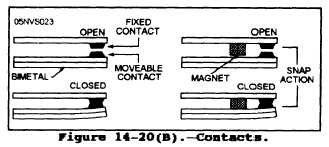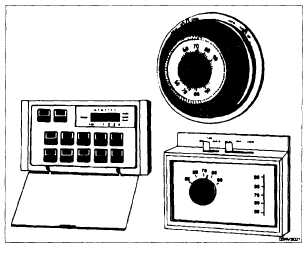
Figure 14-20(B).
THERMOSTATS
The thermostat is a control that responds to changes in temperature and directly or indirectly controls the temperature. There are many different designs of thermostats. Figure 14-20 shows a few of the common thermostats used in modem heating and cooling systems. Thermostats are of three types: heating, cooling, and dual (combined heating and cooling thermostat in one).

Figure 14-20(A). - Bimetal profiles.

Figure 14-20. - Thermostats.
The common sensing element of a thermostat is bimetal. A bimetal sensing element simply uses two different types of metal, brass and invar, which have different expansion rates. Figure 14-20(A) depicts three common profiles of bimetals used in thermostats.
The bimetal element in 14-20(B) has a set of contacts on one end. The top contact is fixed. When the temperature changes around the bimetal, the two contacts open or close.
When the contacts close, a path is created for current to flow. The snap action in the magnetic type makes the contacts close or open quickly. This eliminates any spark and extends the life of the contacts. Figure 14- 20(C) shows enclosed contacts that use a

Figure 14-20(C). - Contacts.
bimetal element for movement and contacts or mercury for making contact between two electrodes.
Continue Reading